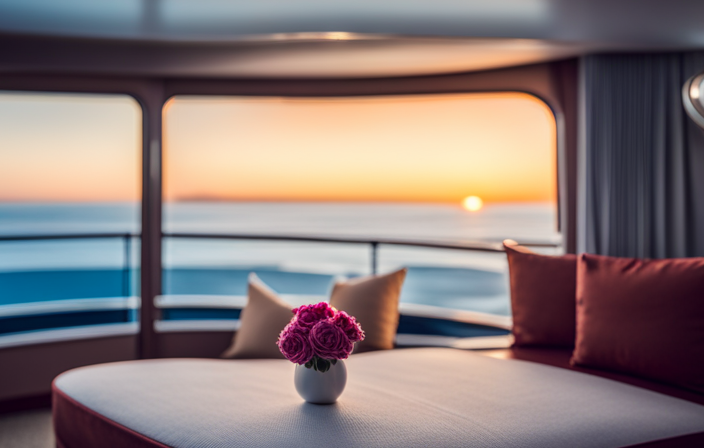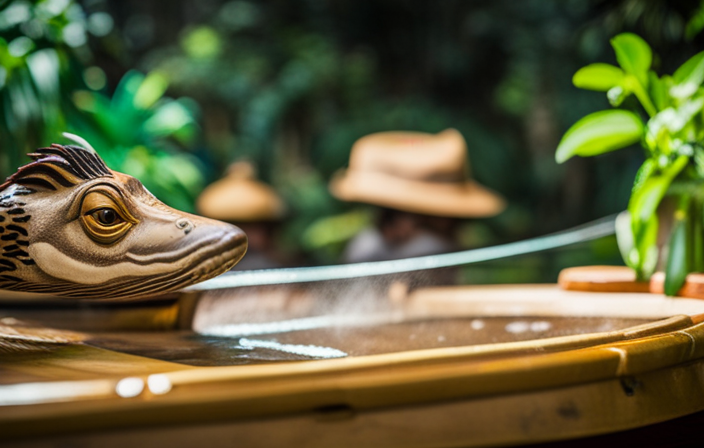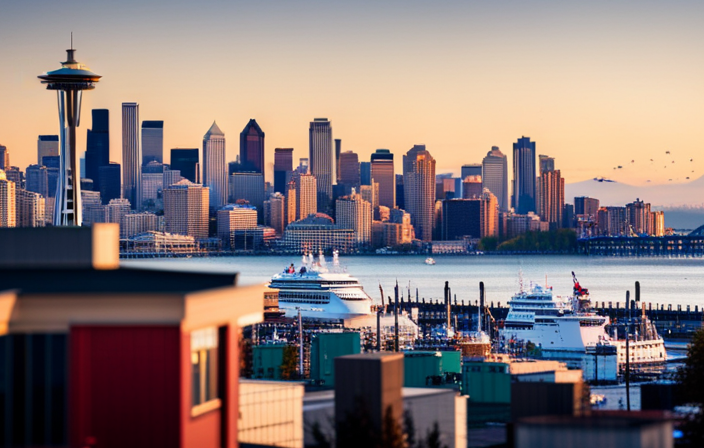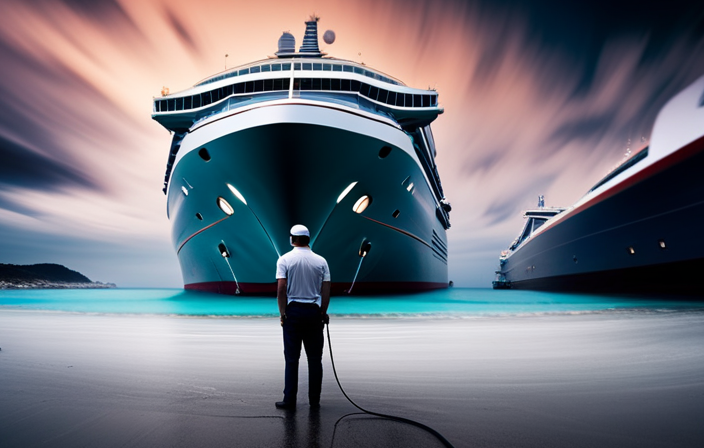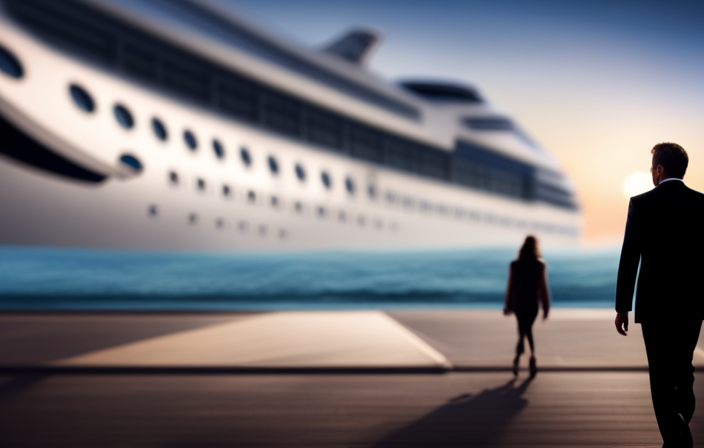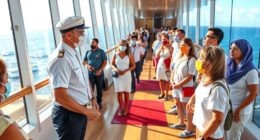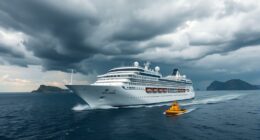The saying, “use it up, wear it out, make it do, or do without,” is especially important to keep in mind when thinking about the large amount of food that cruise ships throw away. As someone who loves traveling and cares about the environment, I am very curious about how cruise ships deal with their food waste.
In this article, we will explore the comprehensive strategies employed by these floating cities to manage their food waste in an efficient and environmentally-friendly manner.
From composting to recycling and repurposing, cruise ships have implemented various techniques to minimize their ecological footprint. We will delve into the practices of donating leftover food to local communities and implementing efficient storage systems.
Moreover, we will discuss how anaerobic digestion is used for energy production and explore innovations in food waste reduction technologies.
By examining these approaches, we can gain insight into the environmental benefits achieved by cruise ships and their future sustainability goals. Join me as we uncover how these floating behemoths are taking proactive steps towards reducing food waste and preserving our planet’s resources.
Key Takeaways
- Cruise ships educate passengers and crew members through interactive workshops, brochures, videos, and training to promote sustainable food choices and waste reduction.
- Food waste tracking systems are implemented to monitor and analyze food waste production, gather valuable data, and implement targeted strategies for waste reduction.
- Smart composting technology is used to manage organic waste by rapidly breaking down food scraps into nutrient-rich compost, which can be used onboard or donated to local farms and gardens.
- Cruise ships contribute to reducing greenhouse gas emissions by diverting food waste from landfills, implementing efficient waste management strategies, and supporting climate change mitigation efforts.
Overview of Food Waste Management on Cruise Ships
On a cruise ship, the crew efficiently manages food waste to ensure proper disposal and minimize it. Composting techniques are crucial in waste management strategies employed by these ships.
The process begins with collecting food scraps from various areas on board, such as the dining areas and galley. These scraps are then transferred to a dedicated composting facility where they undergo decomposition.
This process reduces the volume of food waste and generates nutrient-rich compost. The compost can be used for gardening or landscaping purposes onboard or at port destinations.
Composting serves as a sustainable solution for handling food waste on cruise ships. It minimizes environmental impact while maximizing resource utilization.
Transitioning into the subsequent section about composting as a sustainable solution, it is evident that this practice plays an integral role in reducing overall waste production and promoting eco-friendly practices aboard cruise ships.
Composting as a Sustainable Solution
Composting on board helps cruise lines reduce their environmental impact by turning leftover organic materials into nutrient-rich soil. This contributes to a staggering 80% reduction in landfill waste.
Cruise ships implement various composting techniques to effectively manage food waste. This includes segregating food scraps from non-organic waste and storing them separately for composting purposes.
Composting regulations require strict adherence to guidelines regarding temperature control, moisture levels, and the use of appropriate additives to facilitate decomposition. Cruise lines employ advanced technologies such as aerobic digestion systems or in-vessel composting units to accelerate the composting process and ensure compliance with these regulations.
By implementing these sustainable practices, cruise ships are able to significantly decrease the amount of food waste that ends up in landfills. This transition into recycling and repurposing food waste further minimizes their environmental footprint.
Recycling and Repurposing Food Waste
Implementing sustainable practices on board, cruise lines are able to repurpose and recycle leftover organic materials, contributing to a significant reduction in landfill waste.
Recycling initiatives play a crucial role in minimizing the environmental impact of food waste generated by cruises. By implementing creative solutions, such as anaerobic digestion and composting, cruise ships can divert a substantial amount of organic waste from landfills.
Anaerobic digestion involves breaking down food waste in an oxygen-free environment, producing biogas that can be used for energy production. Composting transforms food scraps into nutrient-rich soil that can be used for gardening or landscaping purposes. These recycling methods not only reduce greenhouse gas emissions but also provide valuable resources for future use.
Transitioning to the next section about donating leftover food to local communities, cruise lines are taking steps to ensure their environmental responsibility extends beyond recycling efforts.
Donating Leftover Food to Local Communities
You can make a positive impact by donating leftover food from your cruise to local communities in need.
Many cruise ships have implemented initiatives to donate excess food to charities and community organizations. By partnering with these organizations, cruise lines ensure that the leftover food is properly distributed to those who are less fortunate.
Donating to charities not only helps reduce food waste but also provides nutritious meals to individuals and families who may not have access to such resources.
According to data, several cruise lines have donated thousands of pounds of food each year, benefiting numerous communities worldwide. These efforts contribute towards reducing hunger and promoting sustainability in the tourism industry.
By donating leftover food, cruise ships demonstrate their commitment to social responsibility and support for local communities.
This approach aligns with the subsequent section about implementing efficient food storage and inventory systems as part of a comprehensive strategy for managing food waste onboard.
Implementing Efficient Food Storage and Inventory Systems
Efficient food storage and inventory systems are essential for cruise lines to minimize food waste and ensure that every morsel of sustenance reaches those in need. Implementing strategies such as proper temperature control, effective packaging techniques, and regular monitoring of expiration dates can help extend the shelf life of perishable items and reduce the chances of spoilage. Robust inventory management systems allow cruise lines to accurately track the quantity and quality of their food supplies, preventing overstocking or underutilization. These data-driven approaches not only contribute to reducing food waste but also help identify areas for further improvements. Transitioning to partnering with local farms and organizations for food waste disposal supports sustainable practices and ensures that no edible item goes to waste.
Partnering with Local Farms and Organizations for Food Waste Disposal
Consider collaborating with local farms and organizations to dispose of excess food in an environmentally friendly manner, ensuring that no edible item goes unused and supporting sustainable practices within the community. Partnering with local farms not only reduces food waste but also provides an opportunity for community engagement. Here are four ways we can achieve this:
-
Establish partnerships: Forge relationships with nearby farms and organizations to donate surplus food. This collaboration not only diverts waste from landfills but also helps support local agriculture.
-
Food recovery programs: Implement systems to collect leftover food on cruise ships and distribute it to local farms for animal feed or composting purposes.
-
Education initiatives: Raise awareness among crew members and passengers about the importance of reducing food waste and encourage them to participate in community-driven efforts.
-
Community events: Organize events where cruise ship passengers can visit local farms or farmer’s markets, fostering a sense of connection between travelers and the communities they visit.
By partnering with local farms and organizations, we can effectively tackle food waste while actively engaging with the community.
Transitioning into the next section, another method to consider is utilizing anaerobic digestion for energy production…
Utilizing Anaerobic Digestion for Energy Production
Cruise ships are utilizing anaerobic digestion for energy production, an innovative method that breaks down organic matter in the absence of oxygen. This process produces biogas, which can be converted into renewable energy. By implementing this technology, cruise ships can efficiently dispose of their food waste while also generating clean energy onboard. This application of anaerobic digestion helps reduce greenhouse gas emissions and decreases dependence on fossil fuels, contributing to a more sustainable cruising experience. Through harnessing the power of anaerobic digestion, cruise lines are making significant strides towards achieving their sustainability goals and minimizing their environmental impact.
Now, let’s delve into how these companies educate passengers and crew on reducing food waste…
Educating Passengers and Crew on Reducing Food Waste
Cruise lines have implemented educational programs for passengers and crew that focus on sustainability and minimizing excess in the galley and dining areas. These programs aim to educate passengers about the impact of food waste on the environment and encourage mindful consumption habits. Crew engagement is also important, as they are trained to promote responsible food practices and provide guidance on portion control.
- Interactive workshops are organized onboard, where passengers can learn about sustainable food choices and how to reduce waste.
- Informational brochures are distributed throughout the ship, highlighting tips for minimizing food waste.
- Engaging videos are shown during mealtimes, showcasing the consequences of excessive food consumption.
By educating both passengers and crew members, cruise lines hope to create a culture of awareness and responsibility regarding food waste. This sets the stage for exploring innovations in food waste reduction technologies.
Innovations in Food Waste Reduction Technologies
Innovative technologies are revolutionizing the way we tackle the issue of food waste on board cruise ships, paving the way for a greener and more sustainable future.
One such technology is food waste tracking systems, which enable ships to monitor and analyze their food waste production. These systems provide valuable data that can be used to identify areas of improvement and implement targeted strategies to reduce waste.
Additionally, smart composting technology has emerged as an effective solution for managing organic waste on cruise ships. This technology utilizes specialized composting machines that rapidly break down food scraps into nutrient-rich compost, which can then be used onboard or donated to local farms and gardens.
These advancements not only minimize environmental impact but also contribute to meeting future sustainability goals in the cruise industry. By implementing these innovative solutions, cruise ships are taking significant steps towards a more sustainable future.
Environmental Benefits and Future Sustainability Goals
In my previous discussion on innovations in food waste reduction technologies, I highlighted some of the impressive advancements that have been made in this area. Now, let’s delve into the environmental benefits and future sustainability goals associated with these waste management strategies.
When it comes to cruise ships, their environmental impact is a significant concern. However, by implementing efficient waste management strategies, such as innovative food waste reduction technologies, they can greatly reduce their ecological footprint. Here are five key environmental benefits and future sustainability goals achieved through these initiatives:
- Reducing greenhouse gas emissions by diverting food waste from landfills.
- Conserving water resources by optimizing food production and consumption.
- Minimizing the release of harmful pollutants into the marine environment.
- Promoting circular economy principles through recycling and composting programs.
- Encouraging sustainable practices throughout the entire supply chain.
By prioritizing these goals and continuously improving waste management strategies, cruise ships can contribute to a more sustainable and environmentally conscious industry.
Frequently Asked Questions
What are the main challenges cruise ships face when managing food waste?
The main challenges faced by cruise ships in food waste management include limited storage space, strict regulations for disposal at sea, and the need for efficient sorting and recycling systems to minimize environmental impact.
How do cruise ships ensure that donated leftover food is safe for consumption?
To ensure food safety during the donation process, cruise ships adhere to strict guidelines. They carefully inspect and package leftover food, ensuring it is properly stored and labeled with expiration dates. This helps guarantee that donated food is safe for consumption.
Are there any regulations in place to ensure cruise ships properly dispose of their food waste?
Regulations on food waste disposal ensure cruise ships handle it responsibly. Strict guidelines require proper segregation, storage, and treatment methods. Compliance is monitored through inspections and audits to prevent environmental harm and maintain hygiene standards.
What measures do cruise ships take to prevent food waste in the first place?
Food waste prevention strategies on cruise ships include menu planning, portion control, and staff training. By carefully managing inventory and monitoring guest preferences, we can reduce food waste onboard and minimize our environmental impact.
How do cruise ships educate their passengers and crew on the importance of reducing food waste?
To educate passengers and crew on reducing food waste, cruise ships use allegorical stories that explain the impact of wasteful habits. Success stories from implementing food waste reduction programs are shared, emphasizing the importance of individual actions in creating a sustainable future.
Conclusion
In conclusion, cruise ships are taking commendable steps towards managing food waste in a sustainable and efficient manner. They are reducing their environmental impact and benefiting local communities through food donations.
Cruise ships utilize composting, recycling, and repurposing methods to handle food waste. These methods help to minimize the amount of waste that ends up in landfills and instead turn it into valuable resources.
Additionally, cruise ships are implementing innovative technologies such as anaerobic digestion. This process further contributes to energy production by converting food waste into biogas, which can be used as a renewable energy source onboard the ship.
To ensure the success of their sustainability efforts, cruise ships also focus on educating both passengers and crew members about the importance of reducing food waste. By raising awareness and promoting responsible consumption, they are paving the way for a greener future.
With these comprehensive measures in place, cruise ships are making significant progress towards achieving their sustainability goals and sailing towards a more environmentally friendly industry.


